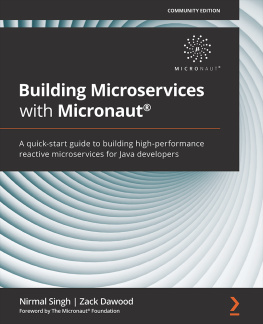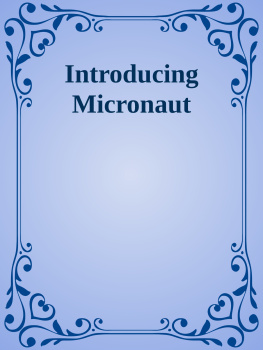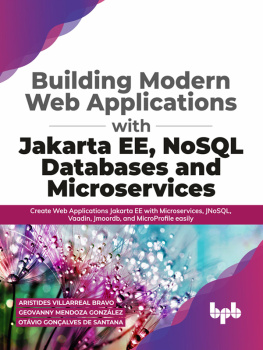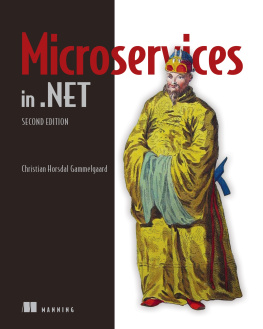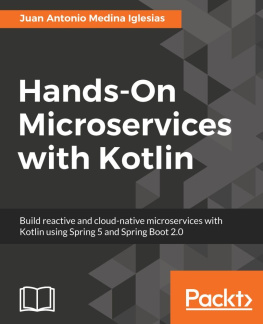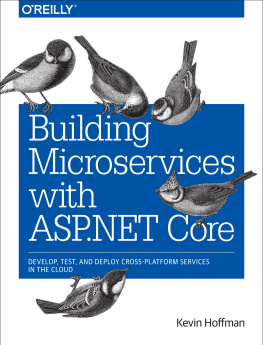Nirmal Singh - Building Microservices with Micronaut®: A quick-start guide to building high-performance reactive microservices for Java developers
Here you can read online Nirmal Singh - Building Microservices with Micronaut®: A quick-start guide to building high-performance reactive microservices for Java developers full text of the book (entire story) in english for free. Download pdf and epub, get meaning, cover and reviews about this ebook. year: 2021, publisher: Packt Publishing, genre: Computer. Description of the work, (preface) as well as reviews are available. Best literature library LitArk.com created for fans of good reading and offers a wide selection of genres:
Romance novel
Science fiction
Adventure
Detective
Science
History
Home and family
Prose
Art
Politics
Computer
Non-fiction
Religion
Business
Children
Humor
Choose a favorite category and find really read worthwhile books. Enjoy immersion in the world of imagination, feel the emotions of the characters or learn something new for yourself, make an fascinating discovery.
- Book:Building Microservices with Micronaut®: A quick-start guide to building high-performance reactive microservices for Java developers
- Author:
- Publisher:Packt Publishing
- Genre:
- Year:2021
- Rating:5 / 5
- Favourites:Add to favourites
- Your mark:
Building Microservices with Micronaut®: A quick-start guide to building high-performance reactive microservices for Java developers: summary, description and annotation
We offer to read an annotation, description, summary or preface (depends on what the author of the book "Building Microservices with Micronaut®: A quick-start guide to building high-performance reactive microservices for Java developers" wrote himself). If you haven't found the necessary information about the book — write in the comments, we will try to find it.
Explore different aspects of building modular microservices such as development, testing, maintenance, and deployment using the Micronaut framework
Key Features- Learn how to build scalable, fast, and resilient microservices with this concise guide
- Explore the many advantages of using reflection-free, compile-time dependency injections and aspect-oriented programming
- Build cloud-native applications easily with the Micronaut framework
The Micronaut open source software is a JVM-based framework, designed to create microservices quickly and easily. This book will help full-stack and Java developers to build modular, high-performing, and reactive microservice-based apps using Micronaut.
Youll start by building microservices and learning about the core components of Micronaut, such as ahead-of-time compilation, reflection-less dependency injection, and reactive baked-in HTTP clients and servers. Next, you will work on a real-time microservice application and learn how to integrate Micronaut with different kinds of relational and non-relational databases. Youll also learn how to employ different security mechanisms to safeguard your microservices and integrate microservices using event-driven architecture in the Apache Kafka ecosystem. As you advance, youll get to grips with automated testing and popular testing tools. The book will help you understand how you can easily handle microservice concerns in the Micronaut framework, such as service discovery, API documentation, distributed configuration management, fallbacks, and circuit breakers. Finally, youll explore the deployment and maintenance aspects of microservices and get up to speed with the Internet of Things (IoT) using Micronaut.
By the end of this book, youll be able to build, test, deploy, and maintain your own microservice apps using Micronaut.
What you will learn- Understand why Micronaut is best suited for building microservices
- Build web endpoints and services in the Micronaut framework
- Safeguard microservices using Session, JWT, and OAuth in Micronaut
- Get to grips with event-driven architecture in Micronaut
- Discover how to automate testing at various levels using built-in tools and testing frameworks
- Deploy your microservices to containers and cloud platforms
- Become well-versed with distributed logging, tracing, and monitoring in Micronaut
- Get hands-on with the IoT using Alexa and Micronaut
This book is for developers who have been building microservices on traditional frameworks such as Spring Boot and are looking for a faster alternative. Intermediate-level knowledge of Java programming and implementing web services development in Java is required.
Table of Contents- Getting Started with Microservices Using the Micronaut Framework
- Working on Data Access
- Working on the RESTful Web Services
- Securing the Microservices
- Integrating Microservices using the Event-Driven Architecture
- Testing the Microservices
- Handling Microservice Concerns
- Deploying Microservices
- Distributed logging, tracing and monitoring
- IoT with Micronaut
- Building enterprise grade microservices
Nirmal Singh: author's other books
Who wrote Building Microservices with Micronaut®: A quick-start guide to building high-performance reactive microservices for Java developers? Find out the surname, the name of the author of the book and a list of all author's works by series.

